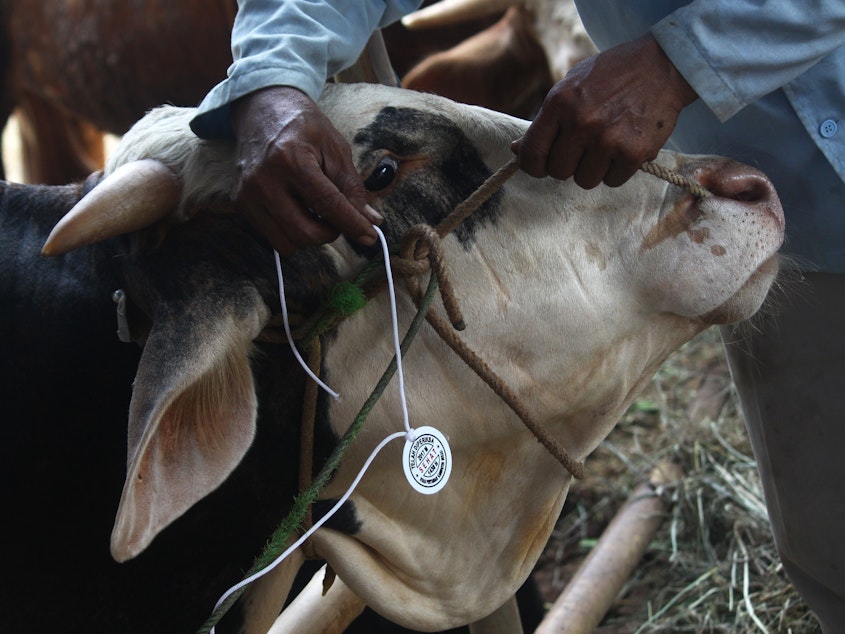The Unanswered Questions About Anthrax

Nowadays, many people associate anthrax with bioterrorism.
Indeed, the anthrax bacteria is "one of the biological agents most likely to be used" in terrorism, according to the Centers for Disease Control and Prevention, because microscopic anthrax spores can be produced in a lab and be put into powders, sprays, food and water.
But that's only part of the anthrax profile. The bacteria occur naturally in soil all over the world. Livestock and wildlife — such as cattle, pigs, goats and deer — can pick up the bacteria as they breathe and graze in grasslands. The bacteria can be transmitted to humans as well — absorbed through a cut in the skin, for example, when slaughtering animals, or from eating infected meat that wasn't cooked at high-enough temperatures.
And there's a lot we don't know about the risks posed by anthrax in nature — notably, how many animal and human cases there are each year.
The World Health Organization says the number of human cases dropped from as many as 100,000 a year down to 2,000 in the 1980s. The number of infected animals per year is not available, but anthrax bacteria are found in the soil of every inhabited continent as well as several islands, including Haiti and parts of the Philippines and Indonesia.
Sponsored
Public health researchers believe cases are chronically underreported both in people and animals — partly because symptoms can mimic the flu and also because herders and hunters fear that news of anthrax in people or animals would take a toll on their livelihood.
To fill in the gaps, a team of researchers have examined 15 years of data to identify hot spots. Colin Carlson, a researcher at Georgetown University, and Ian Kracalik, a former researcher at the University of Florida and now an epidemic intelligence officer at the CDC, led this study, and Jason Blackburn, an associate professor at the University of Florida, led the data collection.
Based on their estimations, 1.1 billion livestock live in areas where the bacterial disease is found. The human involvement is also significant: 1.83 billion people reside in those areas — and approximately 63 million livestock keepers are at high risk.
To determine where anthrax is likeliest to occur around the world, the researchers looked at soil characteristics and climate data. The bacteria thrive in arid and semi-arid climates with slightly alkaline soil but are also present in temperate highlands like in China.
Then the researchers looked at the population of livestock and wild animals in those areas — and the population of humans.
Sponsored
They found that the countries with the greatest number of people at risk are Bangladesh, China, India and South Africa.
Other regions, such as North America, see cases as well. But animals there are routinely vaccinated, and food safety measures keep anthrax-infected meat from being eaten.
Wendy Turner, an assistant professor of biological sciences at University of Albany who was not affiliated with this study, calls the map "a good first start."
"It's kind of surprising that this work has only been done now, to be quite honest," she tells NPR.
How Anthrax Affects Animals and People
Sponsored
An animal that has not been vaccinated will quickly die from an anthrax infection unless antibiotics are administered.
But the vaccine isn't always an easy solution. It must be administered annually. And access to the vaccine may be limited in the poorest parts of the world, Carlson says. Yet those are often the regions where animals — and the people who interact with them — need it the most.
Parts of sub-Saharan Africa as well as south and east Asia have extremely low vaccinations rates — from less than 1 percent to 6 percent, according to this study. These are the regions where more than half of the livestock and 48.5 million livestock keepers are at risk.
People can experience a variety of symptoms if infected. In cases where the bacteria gets under people's skin, symptoms include fever, fatigue and black sores on the skin. About 20 percent of people who get cutaneous anthrax, as this type is called, die if they aren't treated with antibiotics, but nearly everyone survives with treatment.
Those who eat tainted and undercooked meat may also experience nausea, vomiting and diarrhea. Gastrointestinal anthrax has higher fatality rates: more than half of people die with no treatment and 40 percent die even after taking antibiotics.
Sponsored
The deadliest of all is inhalation anthrax. That's the kind that terrorists seek to spread. But it also occurs in nature — if someone working in a slaughterhouse or wool mill inhales spores, for example. With no treatment, 85 to 90 percent of people die, and 45 percent die even with treatment.
There is a vaccine for people, but it is usually only given to first responders to potential terror attacks and to laboratory technicians who work with the bacteria closely.
The Toll It Takes
In affected countries, anthrax infection causes "significant" economic and public health problems, especially in poor, rural communities, says Antonio Vieira, an epidemiologist with the CDC's Division of High-Consequence Pathogens and Pathology who was not part of this research.
"Mapping hot spots or areas more susceptible to anthrax outbreaks is extremely important and helpful for preparedness and targeting interventions," he writes in an email.
Sponsored
The report, the researchers say, is intended as a starting point. From here, public health workers and policymakers can begin focusing on anthrax hot spots and fine-tuning their responses — from administering more livestock vaccinations to training health workers to recognize symptoms in people.
"This is the first global picture we have of this," Carlson says. "It's a little bit like the black hole photo. Now that we can look at this thing — what next?" [Copyright 2019 NPR]



